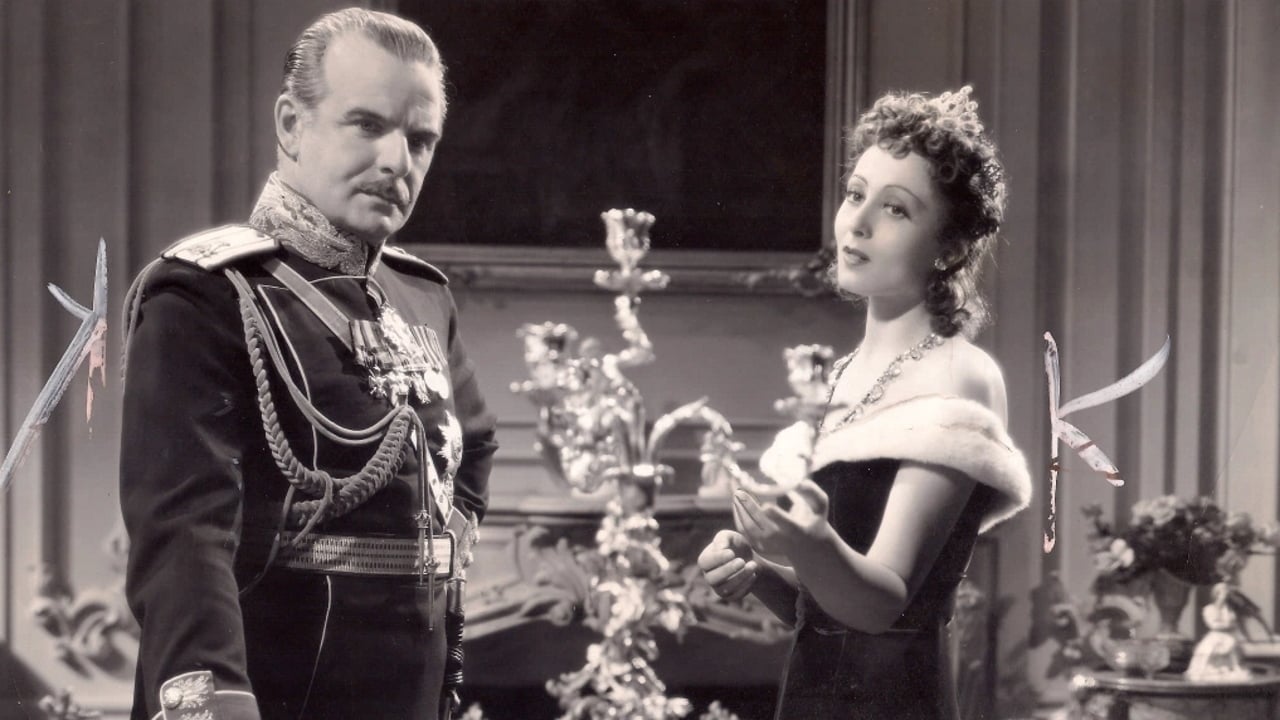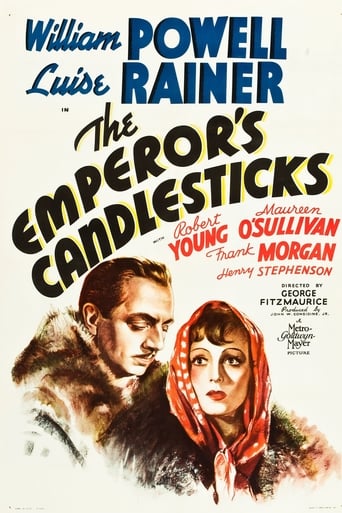Scanialara
You won't be disappointed!
CheerupSilver
Very Cool!!!
Softwing
Most undeservingly overhyped movie of all time??
Numerootno
A story that's too fascinating to pass by...
wes-connors
Dressed up as "Romeo" for a masquerade ball in Vienna, Russian royal Robert Young (as Peter) meets pretty costumed "Juliet" Maureen O'Sullivan (as Maria). They seems like a perfect match, but it's really a plot to abduct Mr. Young. His imperial highness is to be exchanged for her revolutionary father. Young has written a letter to his father, asking him to halt the execution of Ms. Sullivan's father. The letter eventually becomes hidden in "The Emperor's Candlesticks". Chasing them around are a couple of spies, Polish secret agent William Powell (as Stephan Wolensky) and Russian counter-agent Luise Rainer (as Olga Mironova). Of course, the spies become mutually attracted...That may or may not be a good description of the plot; it's simple, but confusingly presented. Director George Fitzmaurice and his editor do not assist in making it understandably smooth. In an interesting scene, we cut from Mr. Powell looking at a train station poster to what looks like a clip from the end of "Anna Karenina" (1935). This is perversely appropriate as Ms. Rainer often appears to be doing impersonations of that film's star, Greta Garbo. By the mid-1930s, Garbo's films were making 2-3 times more money than previously; that's great, but she was averaging only one every two years. MGM needed another glamorously accented worldwide star. Enter Luise Rainer..."The Emperor's Candlesticks" was the first film to feature Ms. Rainer as a big star. While second-billed, she clearly commands the camera's focus; this film was produced for her. It's also the first Rainer made after back-to-back "Best Actress" Academy Award-winning performances in "The Great Ziegfeld" (1936) and "The Good Earth" (1937). The star of Rainer's first two US films, Powell appears more puzzled than passionate in his scenes with Rainer; remember, he's supposed to be falling in love with her. More perturbed than puzzled MGM mogul Louis B. Mayer, who orchestrated Rainer's Oscar-saturated introduction, received notice that his Garbo gamble might not pay off.**** The Emperor's Candlesticks (7/2/37) George Fitzmaurice ~ Luise Rainer, William Powell, Robert Young, Maureen O'Sullivan
edwagreen
No wonder Luise Rainer's career went south following this film and several others. Following her Oscar wins, Ms. Rainer was rushed into some poor films and the results showed quickly.In this film, she sounds like she has congestion, but people would say that this was because of her accent.A tale of Polish and Russian spies, the entire concept needed reworking. The writing is weak, the performances by Rainer and Powell just aren't there because they're given such poor material to work with.As the Countess Mironova, Rainer acts and looks like a refugee living in Brooklyn. She appears as one of the foreigners you would meet at a marketplace.The plot is a good one. Polish nationalists kidnap a Russian emperor's son in the hopes that a Polish nationalist will be freed. Instead of concentrating on this, the film devotes itself to how 2 spies, Rainer and Powell, try to outwit each other by getting the candlesticks which reveal important information inside.Frank Morgan provides some comic relief to Robert Young, the victim of the kidnapping. Yet, his part is mainly understated as is the problem with the entire film.
MartinHafer
The handsome Prince (Robert Young) has been kidnapped and will be killed unless a Polish secret agent (William Powell) is able to sneak a ransom note to the Czar. Unfortunately, he chose a rather silly place to hide the note (inside a specially created candlestick) and it is lost. At the same time, a Russian spy (Luise Rainer) is trying to sneak in letters incriminating Powell as a spy--and also hides them inside the matching candlestick--which also is lost. Lots of intrigue follows--as well as some MGM style romance.This film should have been better. After all, it starred the wonderful William Powell and had such supporting stars as Maureen O'Sullivan, Robert Young, Frank Morgan and Henry Stephenson--all fine actors. However, despite a decent script idea and such talent, the film was only okay. Much of this is because the script was rather tepid and talky--with too many scenes listening to the characters play verbal chess--trying to outfox each other. There was little 'zip' or excitement.In addition, some of the blame probably resides with co-star Luise Rainer. While Ms. Rainer only made a small number of Hollywood films, she had the distinction of winning two straight Best Actress Oscars. However, when you see these two performances as well as her subsequent films you wonder why she received such accolades. The performances just didn't age well. In the last week or so I have seen six of her more famous films, I can't help but think that she was a terribly over-rated star. I'm sure she's a nice person and is still thriving today at 98 years-old. But her style of acting usually included staring wide-eyed into space and often reciting her lines in an over-eager fashion--more like a girl in a high school play than someone trying to play a realistic performance. While Ms. Rainer was better in THE EMPEROR'S CANDLESTICKS than in some of her other films (particularly DRAMATIC SCHOOL and BIG CITY), she still was not up to starring against Powell.Now all this is NOT to say that this is a bad film--it's enjoyable enough. But there just isn't much spark or energy and could have been a lot more interesting. A decent time-passer and that's about it.
som1950
The plot of "The Emperor's Candlesticks" is total nonsense in the 1930s Hollywood fantasies about benevolent despots, courteous kidnappers, and gallant spies. The story is only an excuse for a masquerade ball and a dash across Europe in pursuit of two candelabras that do not belong to the Russian czar or the Austro-Hungarian emperor, but are a gift from an Austrian nobleman to a Russian noblewomen. The carriers (the Polish Baron Wolensky and the Russian Countess Mironova, played by the stars, William Powell and Luise Rainer) lose and find and mistakenly switch the pair of candelabras.Powell was unflappable in the midst of many ludicrous plots during the 1930s, often with Myrna Loy as a co-conspirator. Here, he is pitted against a lovely czarist secret agent, played, in a large wardrobe, by the great Luise Rainer. In the two immediately preceding films for which she won back-to-back Oscars ("The Great Ziegfeld" with Powell and "The Good Earth" with Paul Muni) and in her only other readily available film, "The Great Waltz," she suffered mightily. In "Candlesticks" she got a chance to play the kind of glamorous clothes horse role in which Marlene Dietrich specialized, with no occasion for jealousy at all. Dietrich and Greta Garbo both played spies in 1930s movies. Each appeared more sophisticated than Rainer's, but I find Rainer more credible as a spy with regrets about the consequences of her occupation than either Dietrich or Garbo. Rainer was also quite beautiful with high cheekbones and eyebrows as plucked as Dietrich, and received star keylighting from MGM.Back in a gilded cage, Robert Young got a chance to be charming and gallant, impeded by the humorous bumbling minder played by Frank Morgan.

